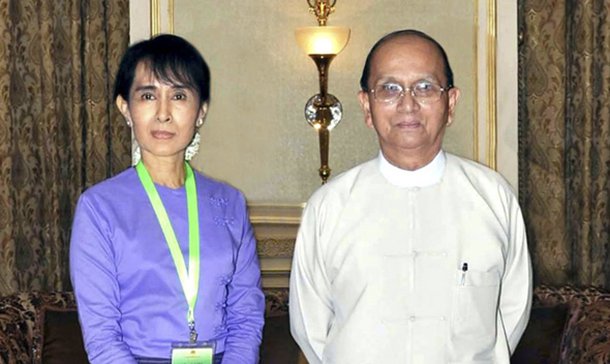RANGOON — The first-ever meeting among Burma’s top government officials, major political parties and ethnic alliances is scheduled for later this week in Naypyidaw, where participants are expected to attempt to resolve the country’s political deadlock and address the direction of future reform.
The government officials joining the meeting on Friday are President Thein Sein, Parliament Speaker Shwe Mann, military Commander in Chief Snr-Gen Min Aung Hlaing and Union Election Commission (UEC) chairman Tin Aye.
Representatives from political parties will include opposition leader Aung San Suu Kyi of the National League for Democracy (NLD), the ruling Union Solidarity and Development Party (USDP) Vice Chairman Htay Oo, and leaders from alliances representing ethnic minorities’ interests.
A senior member of an ethnic alliance invited to the meeting told The Irrawaddy that he had received a phone call about the meeting from the President’s Office on Tuesday, and said the list of those summoned to the meeting included more than four additional parties or ethnic alliances.
“They didn’t tell me anything specific about the theme of the meeting,” he said, adding that he was told not to leak the news to the media before the meeting.
“Given the current situation in Burma, we think that the topics of the meeting will be the country’s political crisis and internal peace,” he added.
Khin Maung Swe, leader of the Federal Democratic Alliance (FDA), confirmed the date and venue of meeting, but said he too was not aware of its agenda. The FDA was invited, as was the United Nationalities Alliance (UNA), headed by Khun Htun Oo.
Since late 2013, the NLD’s Suu Kyi has called for a quadripartite meeting among herself, Thein Sein, Shwe Mann and Min Aung Hlaing, with a focus on discussing amendments to Burma’s controversial Constitution. The president turned down her request, saying Parliament’s Constitutional Review Joint Committee had not yet come forward with proposals to change the 2008 charter.
Observers have warned that the meeting should not be used as a political ploy to appease US President Barack Obama, who will travel to Burma next month to attend the Asean and East Asia summits. Rather, the high-level gathering should serve to lay down a road map for Burma that could lead to long-term national reconciliation, internal peace and democratic reforms.
“They all should know that the people of Burma will hopefully be monitoring the meeting and its outcomes,” said Rangoon-based political observer Yan Myo Thein.
Aung Zaw, founding editor of The Irrawaddy magazine, said if the meeting happens ahead of Obama’s visit, the gathering would serve the shared interest of the US and Burmese governments: reassuring the business community in the West and, for Washington, taking credit for a foreign policy success, having failed elsewhere in the world, from Iraq to Syria to Afghanistan.
“If there is no binding, written statements about the meeting and firm agreement to achieve peace, reconciliation, democracy and freedom in the country, it will only be good PR for the government and military to win the West’s approval and support for the continued illegitimate rule [of the Thein Sein administration] and to ease rising tension and disapproval of the government in domestic politics,” he said.
Burma expert Bertil Lintner told The Irrawaddy that he thought the meeting was not really about breaking political deadlock, and was instead about putting pressure on the various armed ethnic groups to sign a nationwide ceasefire agreement—an achievement the Thein Sein administration has been seeking in vain since he took office in 2011.
“They would like to present Obama with a ceasefire agreement. To be able to say, ‘Look, now there’s peace in the country,” the Swedish journalist said, adding that Naypyidaw’s push for a ceasefire before initiating a political dialogue to address ethnic groups’ concerns was “an upside-down process.”
“Normally, in any peace process anywhere in the world, you announce a ceasefire—you don’t need to sign anything—you just say, ‘I’m not going to shoot you if you don’t shoot at me.’ … You announce a ceasefire, you talk, you reach a consensus, you sign an agreement.”
Instead, the sequence set by the government amounted to “a trap,” Lintner said.
“They’ll have a meeting and they’ll say, ‘OK, yeah, had a good meeting, let’s meet again in six months, and let’s meet again in [another] six months.’ And gradually they will wear them down, the ethnic constituents, and defeat them by political means rather than military means, and this I think is the ultimate aim of the military.”

















